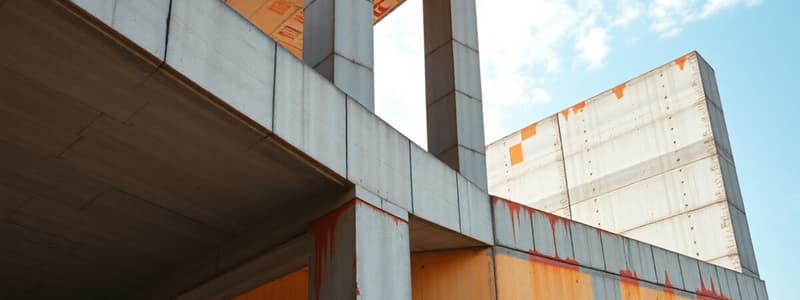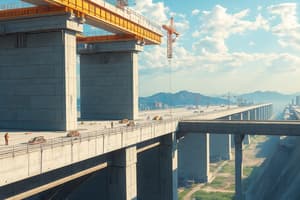Podcast
Questions and Answers
What is the main purpose of prestressing concrete?
What is the main purpose of prestressing concrete?
- To reduce the weight of concrete structures
- To enhance the aesthetic appeal of concrete surfaces
- To increase the tensile strength of concrete
- To prevent cracking under service loads (correct)
Which type of prestressing utilizes high-strength steel tendons within the concrete?
Which type of prestressing utilizes high-strength steel tendons within the concrete?
- Unbonded prestressing
- Historic prestressing
- Bonded prestressing (correct)
- Passive prestressing
What is one major loss associated with prestressing in concrete structures?
What is one major loss associated with prestressing in concrete structures?
- Modulus loss
- Shrinkage loss (correct)
- Fracture loss
- Elastic loss
In the analysis of rectangular beams, which factor is essential for determining bending stress?
In the analysis of rectangular beams, which factor is essential for determining bending stress?
Which method is commonly used for prestressing concrete beams?
Which method is commonly used for prestressing concrete beams?
Flashcards are hidden until you start studying
Study Notes
Introduction to Prestressed Concrete
- Prestressed concrete is a structural concrete that is strengthened by introducing internal tensile forces that oppose the tensile forces caused by external loads.
- Prestressed concrete uses high-strength concrete and steel tendons.
- Types of prestressing:
- Pre-tensioning: Tendons are tensioned before concrete is poured, creating a force that is locked in place as the concrete sets.
- Post-tensioning: Tendons are tensioned after concrete has hardened, allowing for greater control over the tensioning process.
- Methods of prestressing:
- External prestressing: Tendons are placed outside the concrete member, and tensioned to apply a compressive force.
- Internal prestressing: Tendons are placed within the concrete member, commonly using ducts or voids.
- Pre-stressing systems:
- Bonded: Tendons are permanently encased in concrete, resulting in a monolithic structure.
- Unbonded: Tendons are not encased in concrete, allowing for the removal of a portion of the tendon after tensioning.
- Losses of prestress:
- Elastic shortening: Concrete's deformation under load.
- Creep: Long-term deformation of concrete under sustained loads.
- Shrinkage: Reduction in volume of concrete due to drying.
- Friction: Resistance between tendons and surrounding concrete
- Relaxation: Loss of stress in the tendons over time.
Analysis of Rectangular and Flanged Beams
- The analysis of prestressed concrete beams involves determining the stresses and deflections under various load conditions.
- Rectangular beams have a uniform cross-section, while flanged beams feature a larger top or bottom section (flange) for increased strength and support.
- Load calculations and analysis methods differ depending on the shape of the beam, load type (dead load, live load), and the prestressing system.
- The stress distribution in prestressed concrete beams is influenced by factors like the prestressing force, location of the tendons, and the cross-sectional shape of the beam.
- Key design considerations:
- Achieving a balanced section to minimize tensile stresses.
- Optimizing the placement of prestressing tendons for maximum efficiency.
- Addressing potential crack formation and minimizing flexural failure risks.
Studying That Suits You
Use AI to generate personalized quizzes and flashcards to suit your learning preferences.




